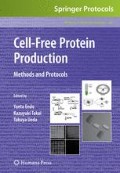Abstract
The Escherichia coli-based reconstituted cell-free protein synthesis system, which we named the PURE (Protein synthesis Using Recombinant Elements) system, provides several advantages compared with the conventional cell-extract-based system. Stability of RNA or protein is highly improved because of the lack of harmful degradation enzymes. The system can be easily engineered according to purposes or the proteins to be synthesized, by manipulating the components in the system. In this chapter, we describe the construction and exploitation of the PURE system. Methods for preparing and assembling the components composing the PURE system for the protein synthesis reaction are shown.
Access this chapter
Tax calculation will be finalised at checkout
Purchases are for personal use only
References
Shimizu, Y., Kuruma, Y., Ying, B. W., Umekage, S., and Ueda, T. (2006) Cell-free translation systems for protein engineering. FEBS J. 273, 4133–4140.
Ozaki, Y., Suzuki, T., Kuruma, Y., Ueda, T., and Yoshida, M. (2008) UncI protein can mediate ring-assembly of c-subunits of FoF1-ATP synthase in vitro. Biochem. Biophys. Res. Commun. 367, 663–666.
Katzen, F., Fletcher, J. E., Yang, J. P., Kang, D., Peterson, T. C., Cappuccio, J. A., et al. (2008) Insertion of membrane proteins into discoidal membranes using a cell-free protein expression approach. J. Proteome Res. 7, 3535–3542.
Hartman, M. C., Josephson, K., Lin, C. W., and Szostak, J. W. (2007) An expanded set of amino acid analogs for the ribosomal translation of unnatural peptides. PLoS ONE 2, e972.
Leemhuis, H., Stein, V., Griffiths, A. D., Hollfelder, F. (2005) New genotype-phenotype linkages for directed evolution of functional proteins. Curr. Opin. Struct. Biol. 15, 472–478.
Kigawa, T., Yabuki, T., Yoshida, Y., Tsutsui, M., Ito, Y., Shibata, T. et al. (1999) Cell-free production and stable-isotope labeling of milligram quantities of proteins. FEBS Lett. 442, 15–19.
Madin, K., Sawasaki, T., Ogasawara, T., and Endo, Y. (2000) A highly efficient and robust cell-free protein synthesis system prepared from wheat embryos: plants apparently contain a suicide system directed at ribosomes. Proc. Natl. Acad. Sci. U.S.A. 97, 559–564.
Shimizu, Y., Inoue, A., Tomari, Y., Suzuki, T., Yokogawa, T., Nishikawa, K. et al. (2001) Cell-free translation reconstituted with purified components. Nat. Biotechnol. 19, 751–755.
Ohashi, H., Shimizu, Y., Ying, B. W., and Ueda, T. (2007) Efficient protein selection based on ribosome display system with purified components. Biochem. Biophys. Res. Commun. 352, 270–276.
Murakami, H., Ohta, A., Ashigai, H., and Suga, H. (2006) A highly flexible tRNA acylation method for non-natural polypeptide synthesis. Nat. Methods 3, 357–359.
Shimizu, Y., Kanamori, T., and Ueda, T. (2005) Protein synthesis by pure translation systems. Methods 36, 299–304.
Olins, P. O., and Rangwala, S. H. (1989) A novel sequence element derived from bacteriophage T7 mRNA acts as an enhancer of translation of the lacZ gene in Escherichia coli. J. Biol. Chem. 264, 16973–16976.
Author information
Authors and Affiliations
Editor information
Editors and Affiliations
Rights and permissions
Copyright information
© 2010 Humana Press, a part of Springer Science+Business Media, LLC
About this protocol
Cite this protocol
Shimizu, Y., Ueda, T. (2010). PURE Technology. In: Endo, Y., Takai, K., Ueda, T. (eds) Cell-Free Protein Production. Methods in Molecular Biology, vol 607. Humana Press. https://doi.org/10.1007/978-1-60327-331-2_2
Download citation
DOI: https://doi.org/10.1007/978-1-60327-331-2_2
Published:
Publisher Name: Humana Press
Print ISBN: 978-1-60327-330-5
Online ISBN: 978-1-60327-331-2
eBook Packages: Springer Protocols

